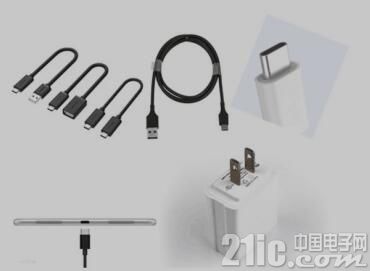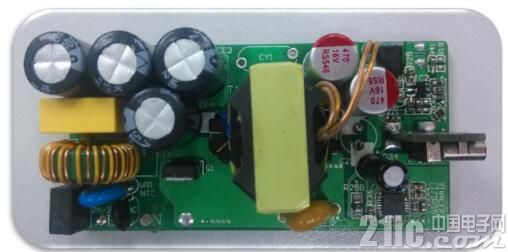Datongda Holdings, a leading semiconductor component distributor dedicated to the Asia-Pacific market, announced that its company will introduce Vishay-based DC bridge stacks, Toshiba's FETs, diodes, optocouplers and TI's PWM controllers. Low-voltage FET, synchronous rectification control and USB PD controller, USB Type-C charging solution compliant with USB PD standard.
This article refers to the address: http://

Figure 1 - USB Type-C charging diagram for USB PD
USB PD (USB Power Delivery Specification) is a standard that can supply up to 100W of power using USB interface. It can carry higher voltage and current. The power supply capacity is up to 100W. It is divided into 10W, 18W, 36W, 60W and 100W. The voltage is 5V, 12V and 20V; the current is 1.5A, 2A, 3A and 5A. In other words, the charger that supports the USB PD protocol can charge portable electronic devices such as mobile phones and tablet computers, and can also charge devices such as notebooks, and can change the direction of power supply at will.
According to IHS Technology, the number of smartphones using Type-C in the world will be close to 100 million units in 2016, and will reach 944 million by 2020. The USB-PD feature will be one of the biggest highlights. Therefore, the United Nations General Assembly has taken the footsteps of the market and launched a USB Type-C charging solution that complies with the USB-PD standard based on many international manufacturers.

Figure 2 - System diagram of USB Type-C charging solution supporting USB PD standard based on many international manufacturers
Functional description
1 Input 90-264VAC, output 5V/3A, 12V/3A
2 constant voltage, constant current output
3 Support Type-C interface
Important feature
1 50mW No Load standby power consumption
2 with synchronous rectification
3 Support USB PD2.0 protocol and Type-C interface

Figure 3 - Photo of USB Type-C charging solution development board supporting USB PD standard based on many international manufacturers
Fiber Optic Cable Channel Assembly
An optical fiber trough is a cable trough for laying soft optical fibers. Material general points: flame retardant engineering plastics, aluminum alloy, steel several. Width is 120mm, 200mm, 240mm, 300mm, 340mm, 400mm, height is generally 100mm. Other sizes can be customized by manufacturers in case of mass purchase. Generally, it is used for wiring in indoor machine rooms.
Classification of optical fiber troughs
1. Plastic optical fiber trough
Plastic fiber groove is a new product developed according to the requirements of high standard machine room construction, absorbing the advantages of foreign products combined with China's national conditions. The groove body and fiber outlet and other accessories are made of high-quality flame retardant materials, good integrity, simple installation, corner corner protection, to ensure that the bending radius of the fiber is greater than 40mm; The fiber outlet is made of flame-retardant plastic and protected with rounded corners. It can be moved freely in the tank to facilitate fiber laying in the appropriate position.
2. Aluminum alloy optical fiber trough
Aluminum alloy fiber groove is designed and manufactured for the various environments and places used in fiber groove, as well as the wishes of customers at home and abroad. It is a new type of fiber groove required by high standard machine room.
The main channel and the column channel are assembled by special aluminum alloy profiles, the surface is chemically treated, and the bottom plate of the channel body is often aluminum plastic plate, which is neat and beautiful. The optical fiber trough can also be separately installed on the cable tray.
Fiber Optic Cable Channel assembly is an essential component of fiber optic networks. It is used to protect and manage fiber optic cables, ensuring that they are properly installed and maintained. This assembly is designed to protect fiber optic cables from environmental factors such as moisture, dust, and temperature changes, which can cause signal loss and degradation.
A fiber optic cable channel assembly typically consists of a channel, a cover, and mounting hardware. The channel is a long, narrow structure that is designed to hold multiple fiber optic cables. It is usually made of metal or plastic and can be mounted to a wall or other structure. The cover is used to protect the cables from external factors and can be made of a variety of materials, including plastic, metal, or fiberglass.
The mounting hardware is used to secure the channel and cover to a wall or other structure. It typically includes screws, bolts, or other fasteners that are designed to hold the assembly in place. Some fiber optic cable channel assemblies also include cable ties or other devices that are used to secure the cables inside the channel.
Fiber optic cable channel assemblies are used in a variety of applications, including telecommunications, data centers, and industrial environments. They are particularly useful in environments where space is limited or where cables need to be protected from external factors. For example, in a data center, fiber optic cable channel assemblies can be used to organize and protect cables running between servers and other equipment.
Fiber Optic Cable Channel Assembly,Optic Fiber Cable Channel,Fiber Optic Channel,Fiber Optic Cable Channels
Rayhot Technology Group Co.,Ltd , https://www.cnrayhot.com
